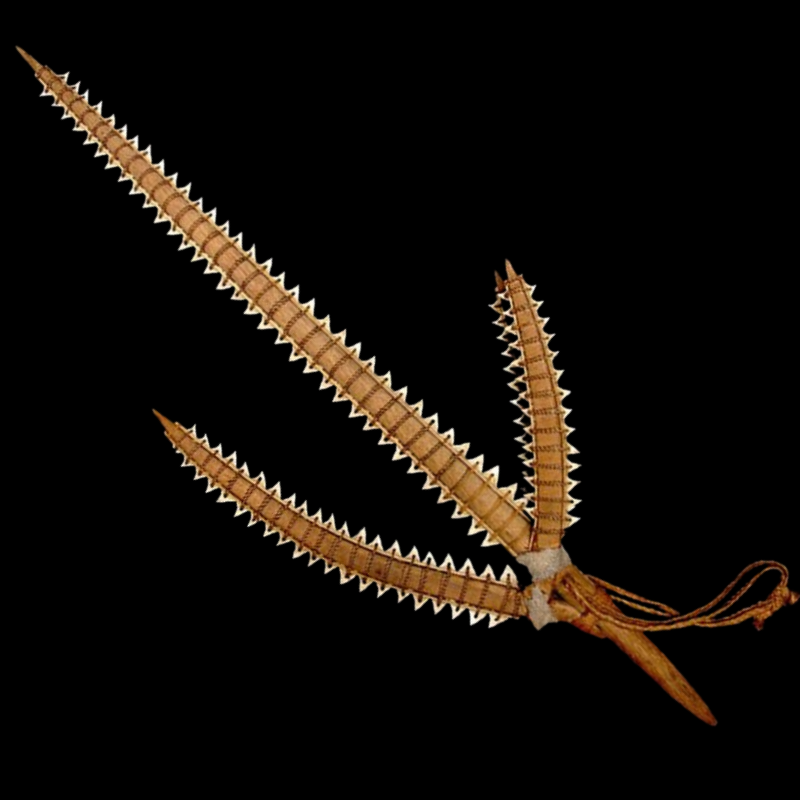This blog post was originally published on 1 November 2021 via my newsletter. Sign up to be the first to read articles like this, delivered straight into your inbox (also, you get a copy of my free book, not bad right?).
This post may contain affiliate links, which means I’ll receive a commission if you purchase through my links and images, at no extra cost to you. Please read the full disclosure here.
Mix a Coconut Tree + Some Shark Teeth in A Bowl and, Hey Presto!
Let’s talk about Kiribati weaponry – or more specifically, shark teeth swords.
Let me explain … as I have been working through my edits for book two, one of my beta readers made a comment asking if I meant ‘sharp sword‘ where I had written ‘shark tooth sword‘. At first, I had a little giggle to myself but then realised the simple description of ‘shark tooth’ sword may not make sense to readers who are not familiar with these weapons – indeed, unless you have Pasifika heritage or possibly have one of these things lying around your house, (which would be rare) you probably wouldn’t have clocked what I meant either.
First I’ll explain why there is mention of a shark tooth sword, and apologies if you have read the first book because you’ll know why. So, as you may, or may not know, there is a character in the series who is referred to as the tattooed man (I know, he will get an actual name eventually, but for the purposes of storytelling, he doesn’t currently need one). As well as being tattooed, this man carries, and sometimes drags behind him, a long-sword that is covered in shark teeth.
Take a look at the images above and below – these are ancient swords and knives that are traditionally found in the southern hemisphere and are specific to Kiribati. Kiribati is known for its unique approach to arms and armour, utilizing that good ol’ fibrous one-seeded drupe, the coconut!
Not only is this good for cocktails (mine’s a Pina Colada) and getting a quick fix of hydration, the coconut is also considered extremely valuable in all Pacific Islands – a.k.a, The Tree of Life. Every part is used and nothing gets wasted, including the husk which is turned into the fibrous material we know as coir.
Weapons were fashioned using the seasoned coconut wood with the shark teeth barbs affixed to them. The teeth mainly derive from the Silver-tip and Dusky sharks, but also the Spot-tail shark. Holes were drilled through at the base of the teeth and intricately tied to the side of the weapons with either pinnacles of the coconut or palm leaf or the long hair of a Kiribati woman.
The most recognisable of the Kiribati weapons is the three-pronged Taumangaria sword – carved from three separate pieces of coconut wood; two slightly smaller pieces sit to the right and left of a longer piece in the centre (see blog image at the top). This is also known as the broken trident sword.
When wielded, these shark teeth weapons were designed to open up the enemies abdomen or brachial artery in the arm but, more often than not, were used in personal combat to protect ones honour and status and therefore only non-fatal injuries tended to occur. If a fatality did happen, the family of the fallen could seek restitution from the surviving combatant’s family in the form of land.
Other types of barbed Kiribati weaponry can be seen in fig. 2. You might think the Tebakabota looks harmless (after all it looks like a witches broom) but I’ve seen a cousin being whacked by one of these and it definitely left some bloody marks. However, the tattooed man, who only appears to Phæ’enor in Benaghar, wields the Taumangaria.
So, whenever you picture him with his shark tooth sword, he’s dragging a very long, three-pronged Taumangaria behind him.

